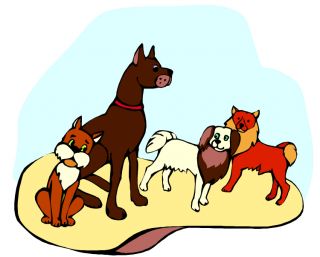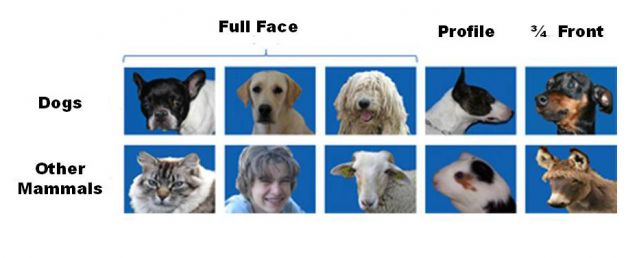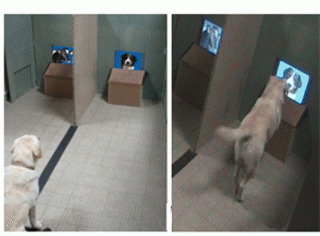Cognition
Do Dogs Know The Difference Between Dogs and Other Animals?
Dogs seem to recognize other dogs, regardless of their breed, size, or shape.
Posted October 8, 2013

I was talking to a colleague of mine who is a professor of biology. He casually commented to me "You know if an astrobiologist from Mars or some other place in the universe came to earth and decided to categorize the animal species on this planet he would most certainly look at a Great Dane, a Border Collie and a Dachshund and decide that they were different species. Such a decision would make sense based simply on the huge differences in their sizes and shapes. So I was wondering, can a dog recognize that all of the other breeds and variations of dogs are the same species that he is?"
Dogs certainly have the greatest variability in size and shape of any of the domesticated animals. They range in weight from the 2 pound Chihuahua to the over 200 pound English Mastiff, and in height at the shoulder from 4 inches up to the 48 inches of the Irish Wolfhound. Their colors can include black, brown, yellow, white, and various shades of red and orange. Their body cover ranges from nearly hairless to extremely long and corded coats, and their coat textures from stiff, to soft, and curly. Their head shapes vary from the narrow pointed muzzle of the Greyhound, to the square and boxy face of the Mastiff. The International Cynologic Federation (FCI) estimates that between 400 and 500 breeds of dogs, all with their own unique size, color, coat and body form, are registered across the various international kennel clubs.
Given all of the variability in the sizes and shapes of dogs, it might seem like a daunting task to ask a dog to recognize all of the varieties that make up our domestic canine species, and to distinguish them from other forms of animals. Yet if we observe the social behavior of dogs they seem to be doing a pretty good job at this. However our casual observations when looking at our own pet dogs are not enough to establish the point, so a team of French researchers led by Dominique Autier-Dérian of the University of Paris, recently decided to experimentally assess whether, using vision alone, dogs could discriminate their own species from others. Their results are published in the journal Animal Cognition.
The nine dogs the researchers used as test subjects all were pets belonging to students at the National Veterinary School of Lyon in France. The breeds varied all over the place and most were crossbreeds.
The really hard work in a study like this involves two aspects of the project, first the selection of the right kind of images to use, and second how to go about the training and testing. The researchers created a massive set of visual stimuli, 3000 images of dogs, and 3000 images of non-dogs. The dog pictures consisted of purebred and mixed-bred canines selected from the four major morphotypes: wolf type, hound type, mastiff type, or greyhound type. It included all of the major different features of head shape, hair length, color, position of ears (upright or floppy). The set of non-dog species included pictures of domestic and wild animals including: farm animals, cats, birds, rabbits, reptiles, wild felines, humans and others. No faces of wolves or foxes were included in the non-dog species since even humans often have difficulty distinguishing these from domestic dogs. The orientation of the heads in the pictures was varied from a full frontal view, to a ¾ front view up to an extreme profile. The backgrounds were all made to be uniform blue. You can see examples in the figure below.

The testing setup was in a small room, with two computer monitors which could be used to display the test images (see the image below). A barrier separated them so that the dog had to clearly choose which side he was going to. The training began with giving the dog the idea that his correct choice was always a dog. Initially the dog had to choose between the image of a dog on one screen and a blank blue screen on the other. If he approached the dog image he heard a click and could return for a bit of a treat. After a while the blank image was replaced with that of a cow, and later the dog image was varied through four different dog images. In all cases the correct choice was the dog.

Now the general testing session began. On each trial there would be a new, never before seen, image of a dog, which was paired with a new, never before seen image, of a non-dog animal. Each testing session consisted of 12 trials. The experimenters were looking at whether dogs could make a discrimination between other dogs compared to non-dog species of animals. All dogs were tested until they reached a performance criterion of 10 out of 12 correct choices on two consecutive days. All of the dogs ultimately managed to do this showing that they had a general concept of "dog".
Now to nail this result down, the experimenters reversed the choices so that the correct choice would now be the non-dog image. For some dogs this was a difficult task, but ultimately all of the dogs learned to make the correct choice and reached criterion.
The important finding of this study is that dogs seem to have a general notion of what fits into the category "dogs" and which animals are clearly not dogs. They can demonstrate this knowledge and their ability to discriminate by either choosing a dog or a non-dog as is required by a particular task.
Since I had just read this recent journal publication I had an answer for my colleague's question. At least I could assure him that according to recent findings, our domestic dogs are more intelligent than your average astrobiologist from Mars when it comes to recognizing what a dog looks like.
Stanley Coren is the author of many books including: The Wisdom of Dogs; Do Dogs Dream? Born to Bark; The Modern Dog; Why Do Dogs Have Wet Noses? The Pawprints of History; How Dogs Think; How To Speak Dog; Why We Love the Dogs We Do; What Do Dogs Know? The Intelligence of Dogs; Why Does My Dog Act That Way? Understanding Dogs for Dummies; Sleep Thieves; The Left-hander Syndrome
Copyright SC Psychological Enterprises Ltd. May not be reprinted, reposted without permission
Data and images from:
Autier-Dérian, D., Deputte, B.L., Chalvet-Monfray, K., Coulon, M. & Mounier, L. (2013). Visual discrimination of species in dogs (Canis familiaris). Animal Cognition, 16:637–651


